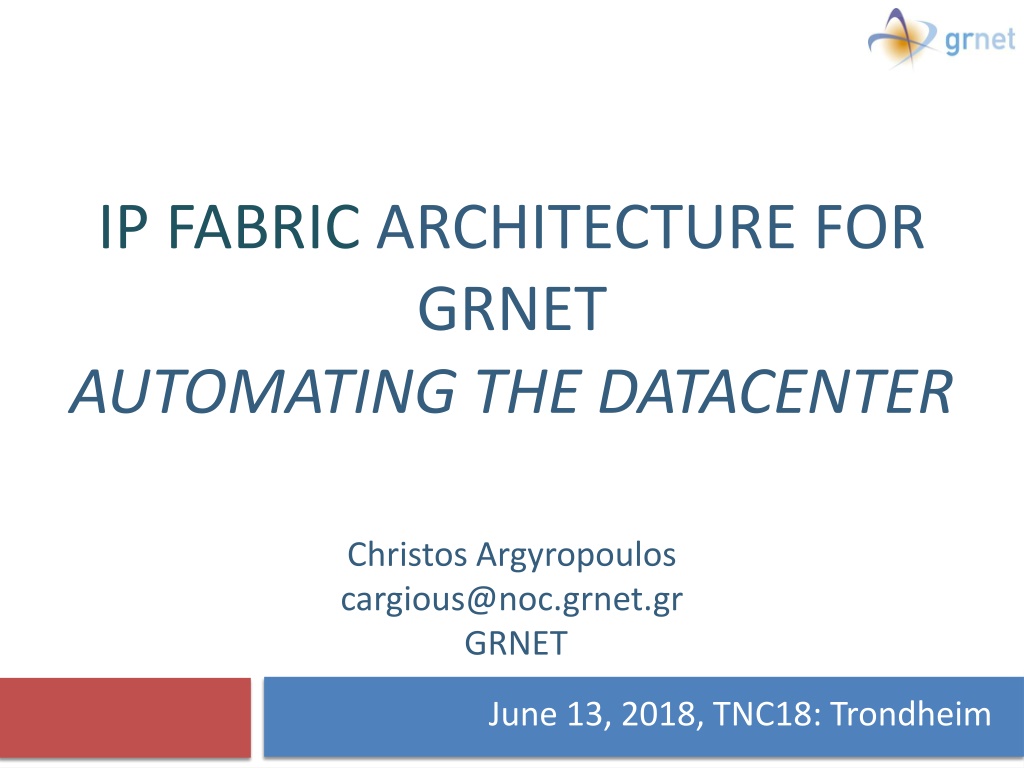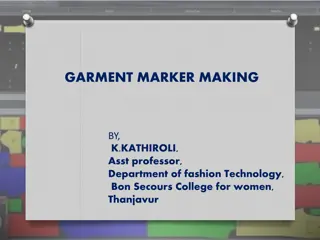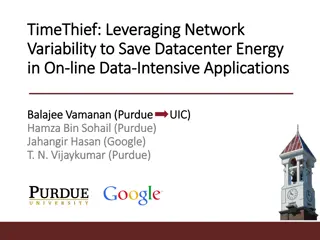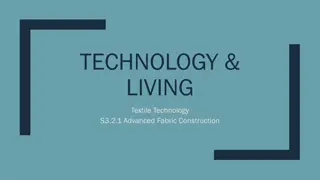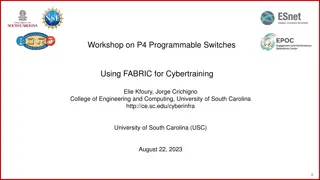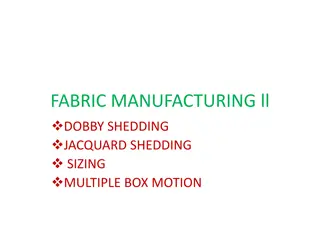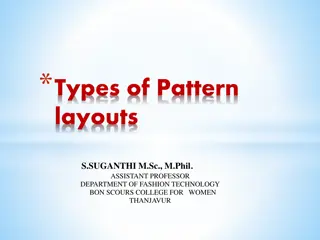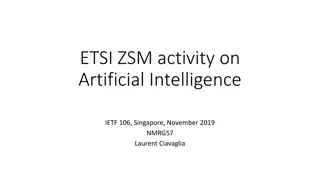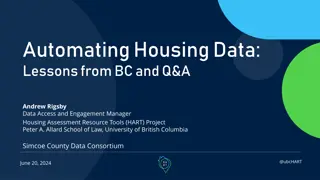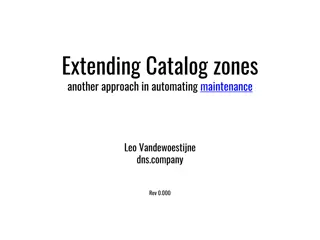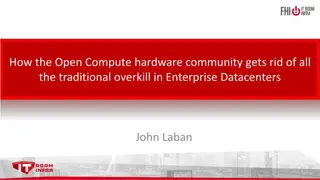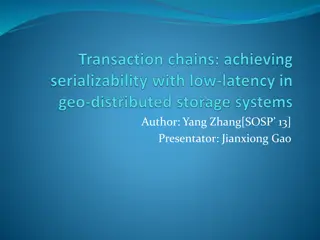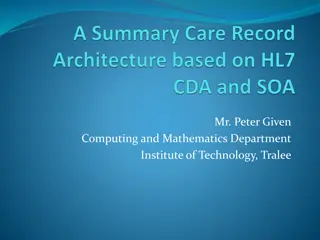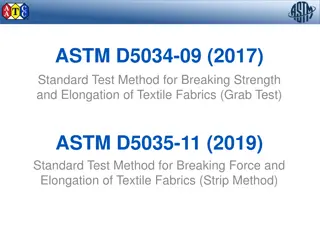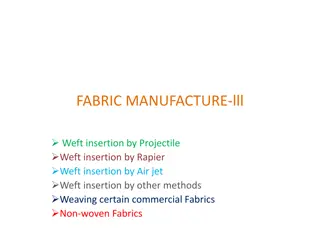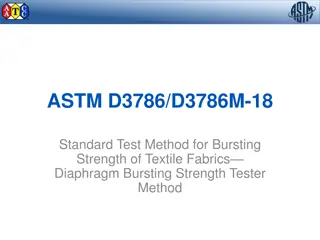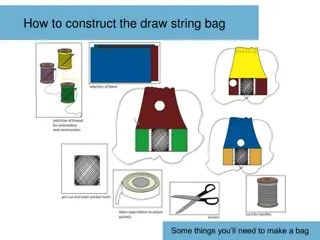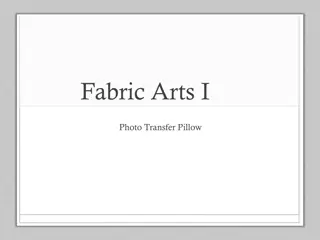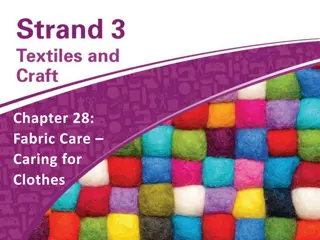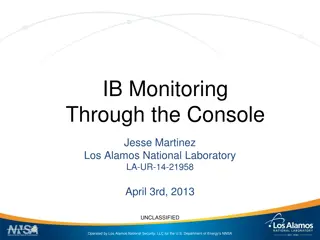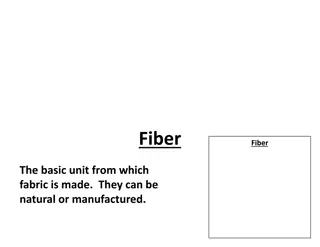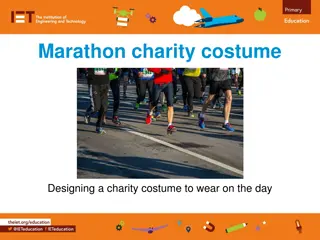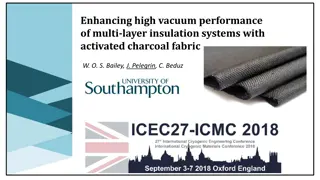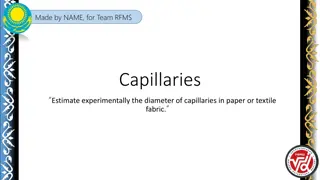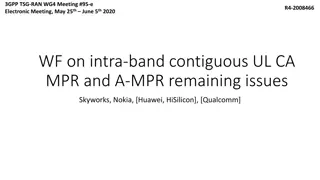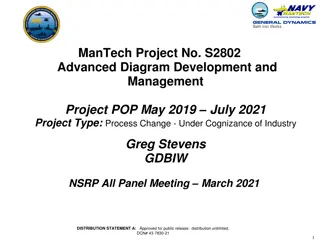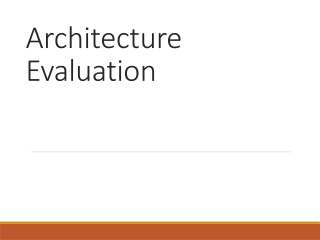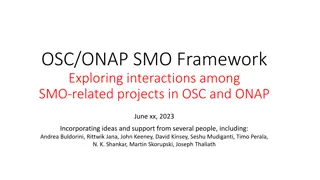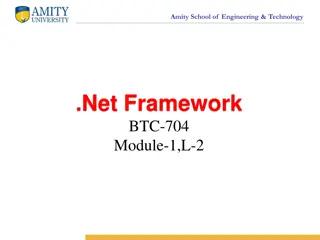IP Fabric Architecture for GRNET Datacenters: Automating the Future
GRNET is expanding its data center infrastructure to address existing problems, balance tested and innovative solutions, and enable VLAN stretching between data centers. The new architecture aims to enhance network efficiency and scalability by implementing an IP Fabric solution. Previous architectures faced limitations in redundancy, link utilization, and VLAN stretching, prompting the need for a more advanced approach. By adopting a single switching fabric and Active/Active connectivity, GRNET is streamlining data center operations and paving the way for automation.
Uploaded on Sep 27, 2024 | 0 Views
Download Presentation

Please find below an Image/Link to download the presentation.
The content on the website is provided AS IS for your information and personal use only. It may not be sold, licensed, or shared on other websites without obtaining consent from the author. Download presentation by click this link. If you encounter any issues during the download, it is possible that the publisher has removed the file from their server.
E N D
Presentation Transcript
IP FABRIC ARCHITECTURE FOR GRNET AUTOMATING THE DATACENTER Christos Argyropoulos cargious@noc.grnet.gr GRNET June 13, 2018, TNC18: Trondheim
The problem 2 Expanding from Two small DCs One larger one: 22 racks To three new datacenters Athens: 36 racks (with the expansion) Knossos: 26 racks Louros: 14 racks Network architecture? Address existing problems Balance between already tested and more innovative solutions Satisfy new requirement: VLAN stretch between datacenters IP Fabric solution for GRNET Datacenters 13 Jun 2018, TNC18, Trondheim
Typical GRNET DC Rack 3 Also: - - Storage Lane Traditional SAN/NAS Baremetal servers or Colocated third party servers Monitoring stations, PDUs, TS, Distributed Object Storage: Debian, Ceph/RADOS - Networking Lane Virtual Machines Lane Debian, KVM, Ganeti, okeanos/vima No routing protocols between hosts & network. Simple linux bridging or ARP proxying IP Fabric solution for GRNET Datacenters 13 Jun 2018, TNC18, Trondheim
GRNET DC Network 4 Single switching fabric across the entire datacenter VLANs stretching DC router(s) Intervlan routing Routing with GRNET IP core Firewalling Server Connectivity Active/Active (LACP) Active/Backup Single homed GRNET Core DC Network IP Fabric solution for GRNET Datacenters 13 Jun 2018, TNC18, Trondheim
Previous Architectures: Ethernet + IP 5 Legacy Ethernet + IP HW redundancy: two of everything First Hop Redundancy: VRRP Redundant connections to the IP Network No Spanning Tree Limitations Servers are multihomed no LACP Poor link utilization (no active/active scenario) BUM & Mac learning problems due to the topology InterDC VLAN stretch without redundancy (L2 VPNs) Mixed mode stacking not so problem free Core Router A Core Router B DC Router A DC Router B Stacked Switch Stacked Switch IP Fabric solution for GRNET Datacenters 13 Jun 2018, TNC18, Trondheim
Previous Architectures: (closed) Fabric architectures 6 Limitations: Complex implementations often problematic in large scale Difficulty in debugging due to closed proprietary solutions Often platforms are immature which results to bugs Eventually too many hours wasted in troubleshooting and bringing the solution to production ready state. All tested solutions already outdated Looking for something new to avoid vendor black box solutions Core Router A Core Router B Aggregat ion Switch Aggregat ion Switch Linecar d switch Linecar d switch LACP LACP Link for multi-chassis synchronization IP Fabric solution for GRNET Datacenters 13 Jun 2018, TNC18, Trondheim
IP Fabric (aka IP Clos): the recipe 7 Overlay Networking with EVPN as control plane In theory decouple the network from the physical hardware programmatically provisioned in a much larger scale All_active physical topologies Anycast layer 3 gateways All traffic is L3 with: VXLAN Dataplane encapsulation for Overlay Tunnels Limitations: network overhead since all VM traffic is now encapsulated with VXLAN header (+64 bits) No STP / no MC-LAG Topology: Build a decades old topology IP Clos Make use of existing hardware Juniper QFX5K as ToR switches Add two new powerhouse Devices for the spine layer Juniper QFX10K IP Fabric solution for GRNET Datacenters 13 Jun 2018, TNC18, Trondheim
VXLAN: Brief introduction 8 Overview All traffic is L3 no need for STP RFC 7348 Tunneling (overlay) protocol that encapsulates all traffic in IP/UDP Can be described as MAC-over- UDP with a globally unique identifier VLAN-like separation, according to VXLAN ID Tunnels are build between VXLAN Tunnel Endpoints (VTEPs) Need of a control plane to minimize flooding and better facilitate learning Forward traffic between IP Fabric nodes referred to as the underlay Payload Outer IP VXLAN VNID Service Separation IP Fabric solution for GRNET Datacenters 13 Jun 2018, TNC18, Trondheim
EVPN: Brief introduction 9 Key Concepts Overview Implemented as another BGP address family (NLRI) Introduces Route Types for Ethernet Segment (ES) Auto discovery MAC/IP advertisement MAC addresses are treated as routable addresses and advertised via BGP BUM traffic and loop avoidance PE devices in same ES auto discovery (allows for active/active) Traffic is sent to the appropriate VTEP (no flooding) Route filtering & route distribution RFC 7432: BGP MPLS-Based Ethernet VPN Co-authored by Cisco,Juniper, Alcatel-Lucent, Verizon, AT&T Stated as evolution over existing L2VPN and VPLS solutions Can use both MPLS and VXLAN as transport Solves flood and learn problem mentioned in VXLAN Provides redundant (anycast) gateways Active / Active server multihoming IP Fabric solution for GRNET Datacenters 13 Jun 2018, TNC18, Trondheim
GRNET IP Fabric topology 10 Spine & Leaf topology Core Router A Core Router B SPINE: Juniper QFX1002 nx10G uplink to GRNET core Juniper QFX10K Juniper QFX 10K LEAF: Juniper QFX5100 2x40G uplink Server: 2x1/10G UTP Multihoming: In pairs of racks LACP or Active-Backup Juniper QFX5K Juniper QFX5K Juniper QFX5K Juniper QFX5K IP Fabric solution for GRNET Datacenters 13 Jun 2018, TNC18, Trondheim
The Underlay Network 11 Each IP Fabric device acts as L3 eBGP between the devices: Route distribution of Loopbacks Multipath load balancing between available paths Loopbacks & Backbone links from 10.0.0.0/8 One Private AS per device Unique assignments within GRNET (for future inter-DC connectivity) Loopback IPs & ASN helps to identify rack number Loopbacks are used as VXLAN VTEPs (Tunneling Endpoints) 65491 65492 65401 65402 65403 65404 IP Fabric solution for GRNET Datacenters 13 Jun 2018, TNC18, Trondheim
The Overlay Network 12 iBGP mesh among all devices Additional AS# for iBGP Spines: route reflectors EVPN address family (nlri) EVPN: Advertise MACs ( ) Each PE advertises its local MACs (per VXLAN) L3 devices advertise MAC-IP bindings (per VXLAN) L3 (gateways)@Spines Mostly because of limitations of the leaves (QFX5100). Distributed Gateway for redundancy and performance Server ports Trunk or access VLAN <-> VXLAN LACP with two PE devices + loop avoidance 65499 65499 65499 65499 65499 65499 IP Fabric solution for GRNET Datacenters 13 Jun 2018, TNC18, Trondheim
L2 stretch between Datacenters 13 Customer data routing is done at the Spines Data Center interconnect using Asymmetric routing Egress PE does only L2 lookup to the local ethernet switching table that is populated from the EVPN control- plane Spines are connected over eBGP underlay to announce the VXLAN termination points (IPs used for the overlay network) Spines are connected over iBGP overlay to announce the MAC+IP NLRIs (EVPN) Ingress MAC-VRF IP-VRF Egress IP-VRF MAC-VRF 4 2 3 5 1 MAC REWRITE IP Fabric solution for GRNET Datacenters 13 Jun 2018, TNC18, Trondheim
Automation 14 Describe the topology with the addressing scheme in one YAML file IP Fabric solution for GRNET Datacenters 13 Jun 2018, TNC18, Trondheim
Ansible and IP Fabric 15 Allow new tasks to be executed and build underlay/overlay topologies New roles (templates + tasks) to our Ansible playbooks dcf-topology dcf-service IP Fabric solution for GRNET Datacenters 13 Jun 2018, TNC18, Trondheim
Introduce a new service 16 Build server interfaces, VLANs and Layer 3 redundant gateways via Ansible IP Fabric solution for GRNET Datacenters 13 Jun 2018, TNC18, Trondheim
Compete playbook run 17 Build one complete IP Fabric DC configuration and deploy L2 and L3 services in under 3 minutes! In this example Ansible has produced configuration for 36 Leaves and 2 Spine switches with 597 interfaces and 377 VLANs (!!!) IP Fabric solution for GRNET Datacenters 13 Jun 2018, TNC18, Trondheim
Reality: An adventure 18 Addressing scheme for VTEP IPs IN-band management -> loopbacks Eventually a new carrier VRF to completely separate the management traffic Underlay ASNs Multiply by number of DCs Many limitations on the Broadcom chipset on QFX5100 Early adoption of EVPN implementation on QFX platforms Bugs Easier troubleshooting due to openness of the solution Lot of support/attention from Juniper (win-win case) Netconf support from the beginning: ease of service deployment and configuration changes with Ansible IP Fabric solution for GRNET Datacenters 13 Jun 2018, TNC18, Trondheim
Thank you! 19 IP Fabric solution for GRNET Datacenters 13 Jun 2018, TNC18, Trondheim
